Materials Handling - Use of Shackles
On this page
What are the types of shackles that you can choose?
Back to topShackles are a load-bearing connecting device, used to securely join parts and rigging. For example, a shackle can be used to attach multiple ropes to a hook or to reduce friction on a line.
A shackle has two main parts, the body and the pin. The body can have an anchor shape (bow) or a chain shape (D or 'Dee' type). Each body shape can be used, depending on the specific application, with a screw pin, bolt-type pin, or round pin.
- When selecting the right shackle, refer to the
manufacturer's tables for the safe working loads of the shackles. The rated capacity should be imprinted on the shackle and be legible . - Other factors to consider include whether the application is permanent or temporary, the application type (for example: rigging, lifting, suspension, towing, tie-downs, etc.), the angle of the load relative to the shackle, and if the load will slide or torque.
- Shackles are sized according to the diameter of the bow section rather than the pin size. Never use a shackle if the distance between the eyes is greater than listed in the manufacturer's tables.
- Consult with the manufacturer if using shackles in extreme conditions (e.g., temperature higher than 204°C or lower than -40°C, or exposure to corrosive fumes).
- Use a shackle when 2 or more ropes must be placed on a hook.
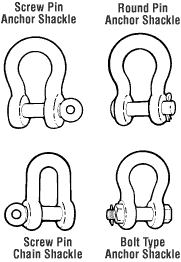
How should you inspect shackles?
Back to top- Inspect shackles regularly. The more extreme the service conditions, the more often they should be inspected.
- Inspections should be performed by a competent person. Refer to the manufacturer’s instructions, safety regulations for the jurisdiction, workplace tackle and rigging plans, and other applicable good practices and standards.
- Inspect the shackle eye and pin holes for stretching (elongation) and wear. Elongation means the metal is being overloaded.
- Inspect the shackle body for bending. A bent shackle indicates excessive side-loading.
- Inspect the shackle identification markings, including manufacturer’s name, shackle weight, serial number, and the working load limit (WLL). Make sure they are present and legible.
- Inspect all shackle pins for distortion, surface blemishes, rust, wear, and fractures.
- All pins must be straight, and all screw pins must be completely seated. Inspect pin threads for wear and damage.
- Inspect for signs of heat and electrical damage, such as discolouration (blue or straw coloured metal) or welding spatter.
- Replace shackles that are bent, show excessive wear by more than 10% of the original diameter, have illegible identification markings, or have an elongated eye or shackle pin holes.
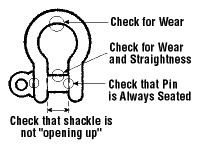
Inspection points for a shackle
What should you avoid when using shackles?
Back to top- Do not replace the shackle pin with a bolt or unidentified pins. A load will bend the bolt.
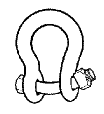
- Do not use a shackle that has been repaired unless it has been certified by a professional engineer after the repair is completed. In general, removing damaged shackles from service is safer than attempting to repair them.
- Do not allow a shackle to be pulled at an angle. The legs will open. Pack the pin with washers to center the shackle.
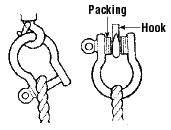
- Do not use screw pin shackles or fit pins in contact with moving parts if the pin can roll and unscrew. If the load shifts, the sling will unscrew the shackle pin.
- Do not use round pin shackles restrained only by a cotter pin for overhead lifting.
![Screw pin shackle with rope showing the pin rolling, illustrating the hazard. Do not use screw pin shackles where the pin can rotate and unscrew.]](https://www.ccohs.ca/images/oshanswers/B17-5.gif)
- Do not use shackles with bent pins or deformed bodies.
- Do not force, hammer, or wedge shackles into position.
- Do not exceed 120 degrees for the angle when using multiple leg slings.
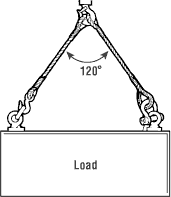
- Fact sheet last revised: 2025-10-22

